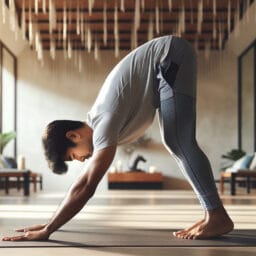Effective Yoga Poses for Alleviating Lower Back Pain
Table of Contents
- Introduction
- Understanding Lower Back Pain
- Preparing for Yoga
- Detailed Description of Effective Yoga Poses for Lower Back Pain
- Benefits of Each Pose
- Conclusion
- Frequently Asked Questions
Introduction
Lower back pain is a common yet challenging physical ailment, affecting an estimated 80% of the adult population at some point in their lives. This discomfort can significantly impact everyday tasks, mental health, and overall quality of life. Easing this prevalent problem often entails a multifaceted approach involving lifestyle modifications and exercise programs. Specifically, yoga poses have proven exceptionally effective in offering lower back pain relief. Yoga not only provides gentle stretching for the tight back muscles but also helps strengthen them over time—optimizing posture and minimizing strain on the lower back. Postures like downward dog or child’s pose may seem simple but can be incredibly potent in releasing tension trapped in the lower body.
However, it’s crucial to remember that while yoga poses could serve as an excellent supplemental solution for low back pain relief, they’re not meant as a standalone treatment for severe cases. Patients with intense or chronic symptoms should consider consulting with a certified physical therapist before integrating any new form of exercise into their routine to avoid potential physical injury. Physical therapy combined with consistent practice of safe yoga poses recommended by experts could pave the way to eliminate low back pain effectively.
Understanding Lower Back Pain
One common cause of lower back pain is physical injury, often resulting from improper lifting techniques or sudden movements. This can strain the back muscles and ligaments, leading to discomfort and reduced mobility. Additionally, block vertebrae symptoms – a condition where two or more spinal bones fuse together – can also contribute to persistent low back pain. Yet, amid these challenges lies an effective non-pharmacological solution: yoga.
The exercise program that yoga offers involves gentle stretching and strength-building poses that target the upper body, particularly the back muscles. Regular practice of specific asanas like ‘downward dog’ and ‘child’s pose’ can gradually release tension in the lower back area while improving overall flexibility. Here’s how it works: imagine you’re in a ‘tabletop position’, your hands are flat on the mat with shoulders stacked directly above your wrists; knees bent at a 90-degree angle pointing under your hips – this is the starting point for most postures.
A certified yoga teacher guides you through modifications that ensure safety while maximizing benefits from each pose. For instance, in downward dog, you would extend your arms out in front while pushing your sitting bones upwards—creating a great stretch along your spine without straining it. Similarly, child’s pose allows for deep relaxation as you extend both arms forward whilst resting your forehead onto the mat—providing relief from neck pain concurrent with lower back discomfort.
Yoga doesn’t just offer physical therapy for lower back pain relief—it also serves as a mental health tool by helping individuals relieve stress through mindful movement and conscious breathing practices. It’s no wonder why many have turned to this age-old practice studied by freelance writers like myself: because when done right under guidance (even if it feels tough mastering what might seem like the hardest yoga pose), Yoga can effectively eliminate low back pain over time.
Detailed Description of Effective Yoga Poses for Lower Back Pain
Incorporating yoga into your routine can be transformative, particularly in offering lower back pain relief through targeted poses. Let’s delve into some of these asanas to understand their execution and benefit.
The Child’s Pose is a calm, restorative position that eases tension in the lower back while also stretching out the hips. Start by sitting on your heels with knees bent. Extend your arms forward onto the mat and rest your head gently downwards; this should form an arc from the base of your spine up to your neck, releasing any trapped stress along this pathway.
Onward to Cat-Cow Pose, which instigates harmonic movement between our head and tailbone—essentially helping to lubricate our spinal column. Begin in a tabletop position: hands flat on the mat under shoulders, knees directly under hips. As you inhale, drop your belly button towards the mat while lifting head and chest upwards (Cow pose); upon exhaling shift into Cat pose by drawing belly upwards towards spine while dropping head and chest down.
Downward-Facing Dog is another highly effective posture for elongating and strengthening back muscles. Transitioning from tabletop position, spread fingers wide on mat for stability before pushing off with hands and feet—this extends sitting bones skywards creating that great stretch along entire body!
Pigeon Pose gives focused attention to each side of our lower body; start by placing left foot behind right wrist while setting right knee behind left hand—gently lowering upper body down onto folded leg provides excellent hip-opening stretch concurrent with low back pain alleviation.
Finally we have Sphinx Pose—a gentle backbend targeting upper body flexibility! Lay stomach-down on mat but prop yourself up using forearms aligned underneath shoulders; maintain connection between belly button and floor as you breathe deeply into this relaxing posture.
Remember safety instructions provided by a certified yoga teacher are crucial when performing these poses especially if you’re recovering from physical injury or suffer block vertebrae symptoms. By following these steps, you will hopefully find a path towards effective lower back pain relief and improved overall mental health!
Conclusion
Embracing yoga as a therapeutic remedy for lower back pain relief involves a tapestry of poses that intend to release tension, strengthen back muscles, and improve flexibility. Notably, the merging of downward dog with gentle stretching can significantly alleviate discomfort in the lower back region. This pose gifts your body with a great stretch – from the sitting bones up to your arms extended forward – ultimately allowing stress to dissipate. It’s essential not just to focus on mastering what may seem like the hardest yoga pose but also genuinely engage in an exercise program that feels good mentally and physically. Consistency is key here; regularity in practicing these yoga poses could even gradually eliminate low back pain if done right! But let’s not forget: always heed safety instructions from certified professionals when practicing these poses, especially if you have block vertebrae symptoms or are recuperating from physical injury. So why wait? Unroll your mat, begin at tabletop position with knees bent under hips and shoulders stacked directly above wrists, take a deep breath—and let yoga work its magic on your lower back pain!



